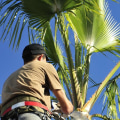Trees are an important part of our environment, but they can also be dangerous if not properly cared for. Knowing how to tell if a tree is dangerous is essential for keeping your property safe. Here are some signs to look out for and what to do if you think your tree is a hazard. When it comes to determining if a tree is dangerous, dead branches are one of the most obvious signs.
Branches larger than 4 inches in diameter can cause significant damage when they fall, so it's important to keep an eye out for them. Additionally, deep cracks or indentations in the bark, or a deep crack in a large branch, can be a sign that the tree is in danger of falling. If you notice large decayed areas on the trunk, branches or root shoot, it's time to call an arborist. Root rot can also be a sign that your tree is in trouble.
If the tree is unable to nourish its branches and leaves, it may need to be removed. Severe weather conditions, diseases or infestations can also cause trees to become hazardous. If you're unsure whether your tree is a hazard or not, it's best to bring in a certified arborist as soon as possible. They will be able to assess the situation and determine if the tree needs to be removed or if it can be saved.
An uneven treetop can also indicate that the weight of the tree is not evenly distributed and that it may not be able to support itself. If you notice visible roots on your tree, this may not necessarily be a problem in itself, but if there are other signs that the tree is struggling, then these protruding roots could mean that the tree is about to fall off. Construction projects can also cause problems for trees left on the property. Cutting down trees during construction can weaken the remaining trees and make them more susceptible to falling over.
If you think your trees are changing or you see any of the warning signs mentioned above, it could mean that they are “danger trees” and likely to fall and cause damage. In this case, it's best to call an arborist as soon as possible. They will be able to assess the situation and determine if the tree needs to be removed or if it can be saved. When examining your trees for potential problems, look for signs such as cankers (discolored or depressed areas in the bark) or fungi growing on the ground at the base of a tree or on the tree itself. These could indicate fungal or bacterial infections which could lead to the death of your tree. If you notice bare patches on your tree, you may be able to save it by watering the area and taping the bark together until it reattaches.
However, don't expect this to save it completely. The best way to protect yourself and your home from an unhealthy or dangerous tree is by hiring a professional arborist to perform a tree inspection on your property. They will be able to identify any potential hazards and advise you on how best to proceed. Finally, remember that roots are essential for keeping trees healthy and strong. If construction equipment damages them during a project, this could eventually lead to the death of the entire tree.


